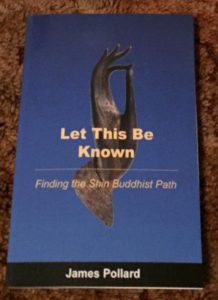
Book Review: Let This Be Known: Finding the Shin Buddhist Path by James Pollard
by Rev. Patti Nakai
This isn’t a book for “nightstand Buddhists” who avoid organized religion and challenges to their so-called spirituality. James Pollard’s Let This Be Known: Finding the Shin Buddhist Path helps readers gain a deep understanding of Shinran’s teachings.
Many books written in English about Jodo Shinshu are introductions. Even two beautifully written books – Taitetsu Unno’s River of Fire, River of Water and Shin Buddhism: Turning Rubble Into Gold – were meant as primers, giving the American public a taste of the Shin tradition. I thought Nobuo Haneda’s book Dharma Breeze: Essays on Shin Buddhism would take people from a preliminary “appetizer” phase to a main course of Jodo Shinshu. But I heard Shin temple members felt Haneda’s book was difficult to understand, along with his translations of works by Manshi Kiyozawa and Shuichi Maida.
Now with Let This Be Known: Finding the Shin Buddhist Path, there’s a bridge that bring readers from the surface generalizations to a deeper understanding of Shinran’s teachings.
Most importantly, Pollard’s collection of essays are directed to those who have joined or who are considering joining a Shin Buddhist community. This is not a book for “nightstand Buddhists” who want to avoid “organized religion” and any challenges to their own conceptions of spirituality. To be on the Shin Buddhist path requires interacting and studying together with fellow seekers.
Although Pollard is a minister’s assistant at the Orange County Buddhist Church, which follows the Nishi Honganji sect, the influence of Higashi Honganji is evident in his presentation. Pollard is a long-time student of Nobuo Haneda, director of the Maida Center of Buddhism in Berkeley. He studied many years with the minister of the Orange County Buddhist Church, Rev. Marvin Harada, currently Buddhist Churches of America bishop.
Harada, during his ministerial training at the Institute of Buddhist Studies in Berkeley, California, was given special permission to spend several months studying with Higashi minister, Rev. Gyomay Kubose, at the Buddhist Temple of Chicago. While attending Ryukoku University, the Nishi Honganji school in Kyoto, he audited classes at Otani University and attended lectures by Higashi ministers. Through Dr. Haneda and Rev. Harada, Pollard understood many aspects of the Buddhist teachings emphasized by Higashi teachers that deviate from standard Nishi Honganji doctrine.
These essays are organized into eight sections, from how we share the historical Buddha’s path of seeking to a rich appreciation of Shinran’s teachings of self-examination and opening our hearts to others. Pollard, as someone who was not brought up in Buddhism or Japanese culture, is able to resonate the words of Shinran from long ago and far away by finding related passages from Western philosophy and culture.
Pollard spends considerable time writing about the natural world through the eyes of science, a reflection of his North American education. His approach is more in sync with the current and future membership of our English-speaking temples than talks by many ministers who assume everyone knows about Japanese stories and customs.
Jodo Shinshu is full of concepts and terms which require, not only detailed explanations, but also time to reflect on their concrete meaning in daily life. Pollard does a wonderful job of presenting Shin Buddhism, not by dumbing it down and making it simplistic, but by showing us subtle and complex aspects of concepts such as shinjin, hongan (Amida Buddha’s primal vow) and nembutsu (reciting the Buddha’s name “Namu Amida Butsu”). He doesn’t speak as an objective authority, but puts himself in the explanations and reflections so we know there’s a real person struggling along with us in listening to the Dharma and making sense of ancient expressions pointing us towards awakening.
In explaining the title, Pollard says,
“Let this be known” (or “”reflect on this”) appears frequently in Shinran’s writings, indicating that his teaching is concerned with self-knowing. He challenges out customary reliance on self-acting, namely, ethical conduct and religious practices.
… A distinguishing feature of Shinran’s teaching is that recognizing my sickness and realizing its cure are simultaneous. For Shinran, the cure is here and now; it is to receive self-awareness by looking in the mirror of the teachings.
Shinran tells us the importance to “reflect on this” – “this” meaning the Shin Buddhist teachings. Pollard in this book shows that Shinran also is saying “let this be known,” making the teachings accessible to us here and now.
– Let This Be Known: Finding the Shin Buddhist Path by James Pollard, Buddhist Education Center, Anaheim, California 2020
-Rev. Nakai is minister of Buddhist Temple of Chicago

